In Situ Synthesis of Cu2O Nanoparticles Using Eucalyptus globulus Extract to Remove a Dye via Advanced Oxidation
Abstract
1. Introduction
2. Materials and Methods
2.1. Preparation of E. globulus Extracts and Synthesis of Cu2O on Supports
2.2. SEM Analysis
2.3. XRD Analysis
2.4. TGA Analysis
2.5. Optical Analysis
2.6. Phytochemical Analysis before and after Synthesis
2.7. MB Degradation by Photocatalysis and Fenton-like Reaction
3. Results
3.1. Synthesis of Nanoparticles Supported
3.2. Characterization of Nanoparticles
3.2.1. SEM-EDX Analysis
3.2.2. XRD Analysis
3.2.3. Raman Analysis
3.2.4. FTIR Analysis
3.2.5. TGA Analysis
3.2.6. Optical Analysis
3.3. Identification of Biomolecules Involved in the Synthesis of Cu2O Nanoparticles
3.3.1. Spectrophotometric Analysis of Extracts before and after Formation Cu2O Nanoparticles
3.3.2. FTIR Analysis of Extracts before and after Formation Cu2O Nanoparticles
3.4. Photocatalytic and Fenton-like Degradation of MB
3.5. Reusability of Photocatalytic and Fenton-like Degradation of MB
3.6. Reactive Species in Photocatalytic and Fenton-like Degradation of MB
4. Conclusions
Author Contributions
Funding
Data Availability Statement
Conflicts of Interest
References
- Yao, J.; Huang, L.; Li, Y.; Zhu, M.; Liu, S.; Shu, S.; Huang, L.; Wu, X. Enhanced photo-degradation of pollutants in three dimensions by rGO/Bi12O15Cl6/InVO4: LED-light photocatalytic performance and mechanism investigation. Ceram. Int. 2023, 49 Pt B, 19422–19433. [Google Scholar] [CrossRef]
- Sun, B.; Li, H.; Li, X.; Liu, X.; Zhang, C.; Xu, H.; Zhao, X.S. Degradation of organic dyes over Fenton-like Cu2O–Cu/C catalysts. Ind. Eng. Chem. Res. 2018, 57, 14011–14021. [Google Scholar] [CrossRef]
- Jo, W.-K.; Tayade, R.J. New generation energy-efficient light source for photocatalysis: LEDs for environmental applications. Ind. Eng. Chem. Res. 2014, 53, 2073–2084. [Google Scholar] [CrossRef]
- Ma, D.; Yi, H.; Lai, C.; Liu, X.; Huo, X.; An, Z.; Li, L.; Fu, Y.; Li, B.; Zhang, M.; et al. Critical review of advanced oxidation processes in organic wastewater treatment. Chemosphere 2021, 275, 130104. [Google Scholar] [CrossRef] [PubMed]
- Zhao, W.; Liang, C.; Wang, B.; Xing, S. Enhanced photocatalytic and Fenton-like performance of CuOx-decorated ZnFe2O4. ACS Appl. Mater. Interfaces 2017, 9, 41927–41936. [Google Scholar] [CrossRef] [PubMed]
- Salgado, P.; Melin, V.; Contreras, D.; Moreno, Y.; Mansilla, H.D. Fenton reaction driven by iron ligands. J. Chil. Chem. Soc. 2013, 58, 2096–2101. [Google Scholar] [CrossRef]
- Zhou, M.; Ji, C.; Ji, F.; Chen, M.; Zhong, Z.; Xing, W. Micro-octahedron Cu2O-based photocatalysis-fenton for organic pollutant degradation: Proposed coupling mechanism in a membrane reactor. Ind. Eng. Chem. Res. 2022, 61, 7255–7265. [Google Scholar] [CrossRef]
- Lopis, A.D.; Choudhari, K.S.; Sai, R.; Kanakikodi, K.S.; Maradur, S.P.; Shivashankar, S.A.; Kulkarni, S.D. Laddered type-1 heterojunction: Harvesting full-solar-spectrum in scavenger free photocatalysis. Sol. Energy 2022, 240, 57–68. [Google Scholar] [CrossRef]
- Dong, J.; Xu, H.; Zhang, F.; Chen, C.; Liu, L.; Wu, G. Synergistic effect over photocatalytic active Cu2O thin films and their morphological and orientational transformation under visible light irradiation. Appl. Catal. A Gen. 2014, 470, 294–302. [Google Scholar] [CrossRef]
- Akbal, F. Photocatalytic degradation of organic dyes in the presence of titanium dioxide under UV and solar light: Effect of operational parameters. Environ. Prog. 2005, 24, 317–322. [Google Scholar] [CrossRef]
- Su, Y.; Nathan, A.; Ma, H.; Wang, H. Precise control of Cu2O nanostructures and LED-assisted photocatalysis. RSC Adv. 2016, 6, 78181–78186. [Google Scholar] [CrossRef]
- Becerra-Paniagua, D.K.; Torres-Arellano, S.; Martinez-Alonso, C.; Luévano-Hipólito, E.; Sebastian, P.J. Facile and green synthesis of Cu/Cu2O composite for photocatalytic H2 generation. Mater. Sci. Semicond. Process 2023, 162, 107485. [Google Scholar] [CrossRef]
- Zhu, H.; Li, Y.; Jiang, X. Room-temperature synthesis of cuprous oxide and its heterogeneous nanostructures for photocatalytic applications. J. Alloys Compd. 2019, 772, 447–459. [Google Scholar] [CrossRef]
- Salgado, P.; Mártire, D.O.; Vidal, G. Eucalyptus extracts-mediated synthesis of metallic and metal oxide nanoparticles: Current status and perspectives. Mater. Res. Express 2019, 6, 082006. [Google Scholar] [CrossRef]
- Kerour, A.; Boudjadar, S.; Bourzami, R.; Allouche, B. Eco-friendly synthesis of cuprous oxide (Cu2O) nanoparticles and improvement of their solar photocatalytic activities. J. Solid State Chem. 2018, 263, 79–83. [Google Scholar] [CrossRef]
- Amrani, M.A.; Srikanth, V.V.S.S.; Labhsetwar, N.K.; Al- Fatesh, A.S.; Shaikh, H. Phoenix dactylifera mediated green synthesis of Cu2O particles for arsenite uptake from water. Sci. Technol. Adv. Mater. 2016, 17, 760–768. [Google Scholar] [CrossRef] [PubMed]
- Muthukumaran, M.; Niranjani, S.; Barnabas, K.S.; Narayanan, V.; Raju, T.; Venkatachalam, K. Green route synthesis and characterization of cuprous oxide (Cu2O): Visible light irradiation photocatalytic activity of MB dye. Mater. Today Proceed. 2019, 14, 563–568. [Google Scholar] [CrossRef]
- Hodges, B.C.; Cates, E.L.; Kim, J.-H. Challenges and prospects of advanced oxidation water treatment processes using catalytic nanomaterials. Nat. Nanotechnol. 2018, 13, 642–650. [Google Scholar] [CrossRef]
- Tu, K.; Wang, Q.; Lu, A.; Zhang, L. Portable visible-light photocatalysts constructed from Cu2O nanoparticles and graphene oxide in cellulose matrix. J. Phys. Chem. C 2014, 118, 7202–7210. [Google Scholar] [CrossRef]
- Zhou, H.; Kang, L.; Zhou, M.; Zhong, Z.; Xing, W. Membrane enhanced COD degradation of pulp wastewater using Cu2O/H2O2 heterogeneous Fenton process. Chin. J. Chem. Eng. 2018, 26, 1896–1903. [Google Scholar] [CrossRef]
- Su, X.; Chen, W.; Han, Y.; Wang, D.; Yao, J. In-situ synthesis of Cu2O on cotton fibers with antibacterial properties and reusable photocatalytic degradation of dyes. Appl. Surf. Sci. 2021, 536, 147945. [Google Scholar] [CrossRef] [PubMed]
- Zhang, L.; Li, J.; Chen, Z.; Tang, Y.; Yu, Y. Preparation of Fenton reagent with H2O2 generated by solar light-illuminated nano-Cu2O/MWNTs composites. Appl. Catal. A-Gen. 2006, 299, 292–297. [Google Scholar] [CrossRef]
- Sabbaghan, M.; Argyropoulos, D.S. Synthesis and characterization of nano fibrillated cellulose/Cu2O films; micro and nano particle nucleation effects. Carbohydr. Polym. 2018, 197, 614–622. [Google Scholar] [CrossRef] [PubMed]
- Salgado, P.; Bustamante, L.; Carmona, D.J.; Meléndrez, M.F.; Rubilar, O.; Salazar, C.; Pérez, A.J.; Vidal, G. Green synthesis of Ag/Ag2O nanoparticles on cellulose paper and cotton fabric using Eucalyptus globulus leaf extracts: Toward the clarification of formation mechanism. Surf. Interfaces 2023, 40, 102928. [Google Scholar] [CrossRef]
- Özyürek, M.; Güçlü, K.; Apak, R. The main and modified CUPRAC methods of antioxidant measurement. Trac-Trends Anal. Chem. 2011, 30, 652–664. [Google Scholar] [CrossRef]
- Gupta, A.; Maruthapandi, M.; Das, P.; Saravanan, A.; Jacobi, G.; Natan, M.; Banin, E.; Luong, J.H.T.; Gedanken, A. Cuprous oxide nanoparticles decorated fabric materials with anti-biofilm Properties. ACS Appl. Bio Mater. 2022, 5, 4310–4320. [Google Scholar] [CrossRef] [PubMed]
- Sedighi, A.; Montazer, M.; Samadi, N. Synthesis of nano Cu2O on cotton: Morphological, physical, biological and optical sensing characterizations. Carbohydr. Polym. 2014, 110, 489–498. [Google Scholar] [CrossRef]
- Mohammadi, F.; Montazer, M.; Mianehro, A.; Eslahi, N.; Mahmoudi Rad, M. Preparation of antibacterial cellulose fabric via copper (II) oxide and corn silk (Stigma maydis) nanocomposite. Starch Stärke 2023, 75, 2200156. [Google Scholar] [CrossRef]
- Prabhakaran, G.; Murugan, R. Synthesis of Cu2O nanospheres and cubes: Their structural, optical and magnetic properties. Adv. Mater. Res. 2014, 938, 114–117. [Google Scholar] [CrossRef]
- Sahai, A.; Goswami, N.; Kaushik, S.D.; Tripathi, S. Cu/Cu2O/CuO nanoparticles: Novel synthesis by exploding wire technique and extensive characterization. Appl. Surf. Sci. 2016, 390, 974–983. [Google Scholar] [CrossRef]
- Yu, P.Y.; Shen, Y.R.; Petroff, Y. Resonance Raman scattering in Cu2O at the blue and indigo excitons. Solid State Commun. 1973, 12, 973–975. [Google Scholar] [CrossRef]
- Solache-Carranco, H.; Juarez-Diaz, G.; Galvan-Arellano, M.; Martinez-Juarez, J.; Romero-Paredes, R.G.; Pena-Sierra, R. Raman Scattering and Photoluminescence Studies on Cu2O. In Proceedings of the 5th International Conference on Electrical Engineering, Computing Science and Automatic Control, Mexico City, Mexico, 12–14 November 2008. [Google Scholar]
- Ansari, A.; Jha, A.K.; Akhtar, M.J. Preparation and characterization of oxidized electrolytic copper powder and its dielectric properties at microwave frequency. Powder Technol. 2015, 286, 459–467. [Google Scholar] [CrossRef]
- Sander, T.; Reindl, C.T.; Klar, P.J. Breaking of Raman selection rules in Cu2O by intrinsic point defects. MRS Proc. 2013, 1633, 81–86. [Google Scholar] [CrossRef]
- Balık, M.; Bulut, V.; Erdogan, I.Y. Optical, structural and phase transition properties of Cu2O, CuO and Cu2O/CuO: Their photoelectrochemical sensor applications. Int. J. Hydrogen Energy 2019, 44, 18744–18755. [Google Scholar] [CrossRef]
- Krysa, M.; Szymańska-Chargot, M.; Zdunek, A. FT-IR and FT-Raman fingerprints of flavonoids—A review. Food Chem. 2022, 393, 133430. [Google Scholar] [CrossRef] [PubMed]
- Espina, A.; Sanchez-Cortes, S.; Jurašeková, Z. Vibrational study (Raman, SERS, and IR) of plant gallnut polyphenols related to the fabrication of iron gall inks. Molecules 2022, 27, 279. [Google Scholar] [CrossRef] [PubMed]
- Edwards, H.G.M.; Farwell, D.W.; Williams, A.C. FT-Raman spectrum of cotton: A polymeric biomolecular analysis. Spectroc. Acta Part A Mol. Biomol. Spectr. 1994, 50, 807–811. [Google Scholar] [CrossRef]
- Agarwal, U.P.; Ralph, S.A.; Baez, C.; Reiner, R.S. Detection and quantitation of cellulose II by Raman spectroscopy. Cellulose 2021, 28, 9069–9079. [Google Scholar] [CrossRef]
- Abidi, N.; Cabrales, L.; Haigler, C.H. Changes in the cell wall and cellulose content of developing cotton fibers investigated by FTIR spectroscopy. Carbohydr. Polym. 2014, 100, 9–16. [Google Scholar] [CrossRef]
- Yang, A.-L.; Li, S.-P.; Wang, Y.-J.; Wang, L.-L.; Bao, X.-C.; Yang, R.-Q. Fabrication of Cu2O@Cu2O core–shell nanoparticles and conversion to Cu2O@Cu core–shell nanoparticles in solution. Trans. Nonferrous Met. Soc. China 2015, 25, 3643–3650. [Google Scholar] [CrossRef]
- Grasel, F.d.S.; Ferrão, M.F.; Wolf, C.R. Development of methodology for identification the nature of the polyphenolic extracts by FTIR associated with multivariate analysis. Spectroc. Acta Part A Mol. Biomol. Spectr. 2016, 153, 94–101. [Google Scholar] [CrossRef] [PubMed]
- Hu, Y.; Pan, Z.J.; Liao, W.; Li, J.; Gruget, P.; Kitts, D.D.; Lu, X. Determination of antioxidant capacity and phenolic content of chocolate by attenuated total reflectance-Fourier transformed-infrared spectroscopy. Food Chem. 2016, 202, 254–261. [Google Scholar] [CrossRef]
- Ventura-Cruz, S.; Tecante, A. Extraction and characterization of cellulose nanofibers from Rose stems (Rosa spp.). Carbohydr. Polym. 2019, 220, 53–59. [Google Scholar] [CrossRef]
- Mohamed, E.A. Green synthesis of copper & copper oxide nanoparticles using the extract of seedless dates. Heliyon 2020, 6, e03123. [Google Scholar] [CrossRef] [PubMed]
- Chinnaiah, K.; Maik, V.; Kannan, K.; Potemkin, V.; Grishina, M.; Gohulkumar, M.; Tiwari, R.; Gurushankar, K. Experimental and theoretical studies of green synthesized Cu2O nanoparticles using Datura metel L. J. Fluoresc. 2022, 32, 559–568. [Google Scholar] [CrossRef] [PubMed]
- Khoshraftar, Z.; Safekordi, A.A.; Shamel, A.; Zaefizadeh, M. Synthesis of natural nanopesticides with the origin of Eucalyptus globulus extract for pest control. Green Chem. Lett. Rev. 2019, 12, 286–298. [Google Scholar] [CrossRef]
- Muthulakshmi, L.; Varada Rajalu, A.; Kaliaraj, G.S.; Siengchin, S.; Parameswaranpillai, J.; Saraswathi, R. Preparation of cellulose/copper nanoparticles bionanocomposite films using a bioflocculant polymer as reducing agent for antibacterial and anticorrosion applications. Compos. Part B Eng. 2019, 175, 107177. [Google Scholar] [CrossRef]
- Brangule, A.; Šukele, R.; Bandere, D. Herbal medicine characterization perspectives using advanced ftir sample techniques—Diffuse reflectance (DRIFT) and photoacoustic spectroscopy (PAS). Front. Plant Sci. 2020, 11, 356. [Google Scholar] [CrossRef]
- Dhara, M.; Kisku, K.; Naik, U.C. Biofunctionalized cuprous oxide nanoparticles synthesized using root extract of Withania somnifera for antibacterial activity. Appl. Nanosci. 2022, 12, 3555–3571. [Google Scholar] [CrossRef]
- Musino, D.; Rivard, C.; Landrot, G.; Novales, B.; Rabilloud, T.; Capron, I. Hydroxyl groups on cellulose nanocrystal surfaces form nucleation points for silver nanoparticles of varying shapes and sizes. J. Colloid Interface Sci. 2021, 584, 360–371. [Google Scholar] [CrossRef]
- Phan, A.D.T.; D’Arcy, B.R.; Gidley, M.J. Polyphenol–cellulose interactions: Effects of pH, temperature and salt. Int. J. Food Sci. Technol. 2016, 51, 203–211. [Google Scholar] [CrossRef]
- Mannarmannan, M.; Biswas, K. Phytochemical-Assisted Synthesis of Cuprous Oxide Nanoparticles and Their Antimicrobial Studies. ChemistrySelect 2021, 6, 3534–3539. [Google Scholar] [CrossRef]
- Taherzadeh Soureshjani, P.; Shadi, A.; Mohammadsaleh, F. Algae-mediated route to biogenic cuprous oxide nanoparticles and spindle-like CaCO3: A comparative study, facile synthesis, and biological properties. RSC Adv. 2021, 11, 10599–10609. [Google Scholar] [CrossRef] [PubMed]
- Seon, J.; Hwang, Y. Cu/Cu2O-immobilized cellulosic filter for enhanced iodide removal from water. J. Hazard. Mater. 2021, 409, 124415. [Google Scholar] [CrossRef] [PubMed]
- da Silva, C.G.; Benaducci, D.; Frollini, E. Lyocell and cotton fibers as reinforcements for a thermoset polymer. BioResources 2012, 7, 0078–0098. [Google Scholar] [CrossRef]
- Gong, X.; Xiong, Z.; Chen, X.; Meng, F.; Wang, H. Multifunctional superamphiphobic cotton fabrics with highly efficient flame retardancy, self-cleaning, and electromagnetic interference shielding. ACS Appl. Mater. Interfaces 2023, 15, 3395–3408. [Google Scholar] [CrossRef] [PubMed]
- Gupta, D.; Meher, S.R.; Illyaskutty, N.; Alex, Z.C. Facile synthesis of Cu2O and CuO nanoparticles and study of their structural, optical and electronic properties. J. Alloys Compd. 2018, 743, 737–745. [Google Scholar] [CrossRef]
- Tauc, J.; Grigorovici, R.; Vancu, A. Optical properties and electronic structure of amorphous germanium. Phys. Status Solidi B Basic Res. 1966, 15, 627–637. [Google Scholar] [CrossRef]
- Alp, E. The Facile Synthesis of Cu2O-Cu hybrid cubes as efficient visible-light-driven photocatalysts for water remediation processes. Powder Technol. 2021, 394, 1111–1120. [Google Scholar] [CrossRef]
- Jiang, H.-Q.; Endo, H.; Natori, H.; Nagai, M.; Kobayashi, K. Fabrication and efficient photocatalytic degradation of methylene blue over CuO/BiVO4 composite under visible-light irradiation. Mater. Res. Bull. 2009, 44, 700–706. [Google Scholar] [CrossRef]
- Xu, Y.; Schoonen, M.A.A. The absolute energy positions of conduction and valence bands of selected semiconducting minerals. Am. Miner. 2000, 85, 543–556. [Google Scholar] [CrossRef]
- Das, S.; Deka, T.; Ningthoukhangjam, P.; Chowdhury, A.; Nair, R.G. A critical review on prospects and challenges of metal-oxide embedded g-C3N4-based direct Z-scheme photocatalysts for water splitting and environmental remediation. Appl. Surf. Sci. Adv. 2022, 11, 100273. [Google Scholar] [CrossRef]
- da Costa, W.V.; Pereira, B.d.S.; Montanha, M.C.; Kimura, E.; Hechenleitner, A.A.W.; de Oliveira, D.M.F.; Pineda, E.A.G. Hybrid materials based on cotton fabric-Cu2O nanoparticles with antibacterial properties against S. aureus. Mater. Chem. Phys. 2017, 201, 339–343. [Google Scholar] [CrossRef]
- Huang, J.-Y.; Madasu, M.; Huang, M.H. Modified semiconductor band diagrams constructed from optical characterization of size-tunable Cu2O cubes, octahedra, and rhombic dodecahedra. J. Phys. Chem. C 2018, 122, 13027–13033. [Google Scholar] [CrossRef]
- Singh, M.; Goyal, M.; Devlal, K. Size and shape effects on the band gap of semiconductor compound nanomaterials. J. Taibah Univ. Sci. 2018, 12, 470–475. [Google Scholar] [CrossRef]
- Chen, T.-N.; Kao, J.-C.; Zhong, X.-Y.; Chan, S.-J.; Patra, A.S.; Lo, Y.-C.; Huang, M.H. Facet-specific photocatalytic activity enhancement of Cu2O polyhedra functionalized with 4-ethynylanaline resulting from band structure tuning. ACS Central Sci. 2020, 6, 984–994. [Google Scholar] [CrossRef] [PubMed]
- Higashimoto, S.; Nishi, T.; Yasukawa, M.; Azuma, M.; Sakata, Y.; Kobayashi, H. Photocatalysis of titanium dioxide modified by catechol-type interfacial surface complexes (ISC) with different substituted groups. J. Catal. 2015, 329, 286–290. [Google Scholar] [CrossRef]
- Gao, C.; Wang, J.; Xu, H.; Xiong, Y. Coordination chemistry in the design of heterogeneous photocatalysts. Chem. Soc. Rev. 2017, 46, 2799–2823. [Google Scholar] [CrossRef] [PubMed]
- Wang, Y.; Miska, P.; Pilloud, D.; Horwat, D.; Mücklich, F.; Pierson, J.F. Transmittance enhancement and optical band gap widening of Cu2O thin films after air annealing. J. Appl. Phys. 2014, 115, 073505. [Google Scholar] [CrossRef]
- Kumar, A.; Kumar, R.; Verma, N.; Anupama, A.V.; Choudhary, H.K.; Philip, R.; Sahoo, B. Effect of the band gap and the defect states present within band gap on the non-linear optical absorption behaviour of yttrium aluminium iron garnets. Opt. Mater. 2020, 108, 110163. [Google Scholar] [CrossRef]
- Norouzzadeh, P.; Mabhouti, K.; Golzan, M.M.; Naderali, R. Investigation of structural, morphological and optical characteristics of Mn substituted Al-doped ZnO NPs: A Urbach energy and Kramers-Kronig study. Optik 2020, 204, 164227. [Google Scholar] [CrossRef]
- Yadav, S.; Jain, A.; Malhotra, P. A review on the sustainable routes for the synthesis and applications of cuprous oxide nanoparticles and their nanocomposites. Green Chem. 2019, 21, 937–955. [Google Scholar] [CrossRef]
- Santos, S.A.O.; Pinto, R.J.B.; Rocha, S.M.; Marques, P.A.A.P.; Neto, C.P.; Silvestre, A.J.D.; Freire, C.S.R. Unveiling the chemistry behind the green synthesis of metal nanoparticles. ChemSusChem 2014, 7, 2704–2711. [Google Scholar] [CrossRef]
- Waris, A.; Din, M.; Ali, A.; Ali, M.; Afridi, S.; Baset, A.; Ullah Khan, A. A comprehensive review of green synthesis of copper oxide nanoparticles and their diverse biomedical applications. Inorg. Chem. Commun. 2021, 123, 108369. [Google Scholar] [CrossRef]
- Djamila, B.; Eddine, L.S.; Abderrhmane, B.; Nassiba, A.; Barhoum, A. In vitro antioxidant activities of copper mixed oxide (CuO/Cu2O) nanoparticles produced from the leaves of Phoenix dactylifera L. Biomass Convers. Biorefinery 2022, 14, 6567–6580. [Google Scholar] [CrossRef]
- Atri, A.; Echabaane, M.; Bouzidi, A.; Harabi, I.; Soucase, B.M.; Ben Chaâbane, R. Green synthesis of copper oxide nanoparticles using Ephedra Alata plant extract and a study of their antifungal, antibacterial activity and photocatalytic performance under sunlight. Heliyon 2023, 9, e13484. [Google Scholar] [CrossRef] [PubMed]
- Akter, J.; Sapkota, K.P.; Hanif, M.A.; Islam, M.A.; Abbas, H.G.; Hahn, J.R. Kinetically controlled selective synthesis of Cu2O and CuO nanoparticles toward enhanced degradation of methylene blue using ultraviolet and sun light. Mater. Sci. Semicond. Process 2021, 123, 105570. [Google Scholar] [CrossRef]
- Bayomie, O.S.; Kandeel, H.; Shoeib, T.; Yang, H.; Youssef, N.; El-Sayed, M.M.H. Novel approach for effective removal of methylene blue dye from water using fava bean peel waste. Sci. Rep. 2020, 10, 7824. [Google Scholar] [CrossRef]
- Salazar-Rabago, J.J.; Leyva-Ramos, R.; Rivera-Utrilla, J.; Ocampo-Perez, R.; Cerino-Cordova, F.J. Biosorption mechanism of methylene blue from aqueous solution onto white Pine (Pinus durangensis) sawdust: Effect of operating conditions. Sustain. Environ. Res. 2017, 27, 32–40. [Google Scholar] [CrossRef]
- Messaadia, L.; Kiamouche, S.; Lahmar, H.; Masmoudi, R.; Boulahbel, H.; Trari, M.; Benamira, M. Solar photodegradation of rhodamine B dye by Cu2O/TiO2 heterostructure: Experimental and computational studies of degradation and toxicity. J. Mol. Model. 2023, 29, 38. [Google Scholar] [CrossRef]
- Qin, H.; Wang, Z.; Yang, S.; Jiang, W.; Gu, Y.; Chen, J.; Yang, G. High efficiency degradation of 2,4-dichlorophenol using Cu2S/Cu2O decorated nanoscale zerovalent iron via adsorption and photocatalytic performances. J. Clean. Prod. 2022, 378, 134587. [Google Scholar] [CrossRef]
- Ai, Z.; Xiao, H.; Mei, T.; Liu, J.; Zhang, L.; Deng, K.; Qiu, J. Electro-fenton degradation of rhodamine b based on a composite cathode of Cu2O nanocubes and carbon nanotubes. J. Phys. Chem. C 2008, 112, 11929–11935. [Google Scholar] [CrossRef]
- Xia, H.; Zhang, Y.; Zhou, P.; Li, C.; Yang, D. Oxidative degradation of organic pollutants using cuprous oxide in acidic solution: Hydroxyl radical generation. Desalin. Water Treat. 2019, 171, 262–269. [Google Scholar] [CrossRef]
- Zayed, M.F.; Eisa, W.H.; Anis, B. Gallic acid-assisted growth of cuprous oxide within polyvinyl alcohol; a separable catalyst for oxidative and reductive degradation of water pollutants. J. Clean. Prod. 2021, 279, 123826. [Google Scholar] [CrossRef]
- Wu, M.; He, S.; Ha, E.; Hu, J.; Ruan, S. A facile synthesis of PEGylated Cu2O@SiO2/MnO2 nanocomposite as efficient photo−Fenton−like catalysts for methylene blue treatment. Front. Bioeng. Biotechnol. 2022, 10, 1023090. [Google Scholar] [CrossRef]
- Cheng, Y.; Lin, Y.; Xu, J.; He, J.; Wang, T.; Yu, G.; Shao, D.; Wang, W.-H.; Lu, F.; Li, L.; et al. Surface plasmon resonance enhanced visible-light-driven photocatalytic activity in Cu nanoparticles covered Cu2O microspheres for degrading organic pollutants. Appl. Surf. Sci. 2016, 366, 120–128. [Google Scholar] [CrossRef]
- Li, Y.; Dong, H.; Xiao, J.; Li, L.; Chu, D.; Hou, X.; Xiang, S.; Dong, Q.; Zhang, H. Advanced oxidation processes for water purification using percarbonate: Insights into oxidation mechanisms, challenges, and enhancing strategies. J. Hazard. Mater. 2023, 442, 130014. [Google Scholar] [CrossRef]
- Winterbourn, C.C. Biological chemistry of superoxide radicals. ChemTexts 2020, 6, 7. [Google Scholar] [CrossRef]
- Liu, Y.; Tan, N.; Guo, J.; Wang, J. Catalytic activation of O2 by Al0-CNTs-Cu2O composite for Fenton-like degradation of sulfamerazine antibiotic at wide pH range. J. Hazard. Mater. 2020, 396, 122751. [Google Scholar] [CrossRef]
- Bayat, F.; Sheibani, S. Enhancement of photocatalytic activity of CuO-Cu2O heterostructures through the controlled content of Cu2O. Mater. Res. Bull. 2022, 145, 111561. [Google Scholar] [CrossRef]
- Chu, C.-Y.; Huang, M.H. Facet-dependent photocatalytic properties of Cu2O crystals probed by using electron, hole and radical scavengers. J. Mater. Chem. A 2017, 5, 15116–15123. [Google Scholar] [CrossRef]

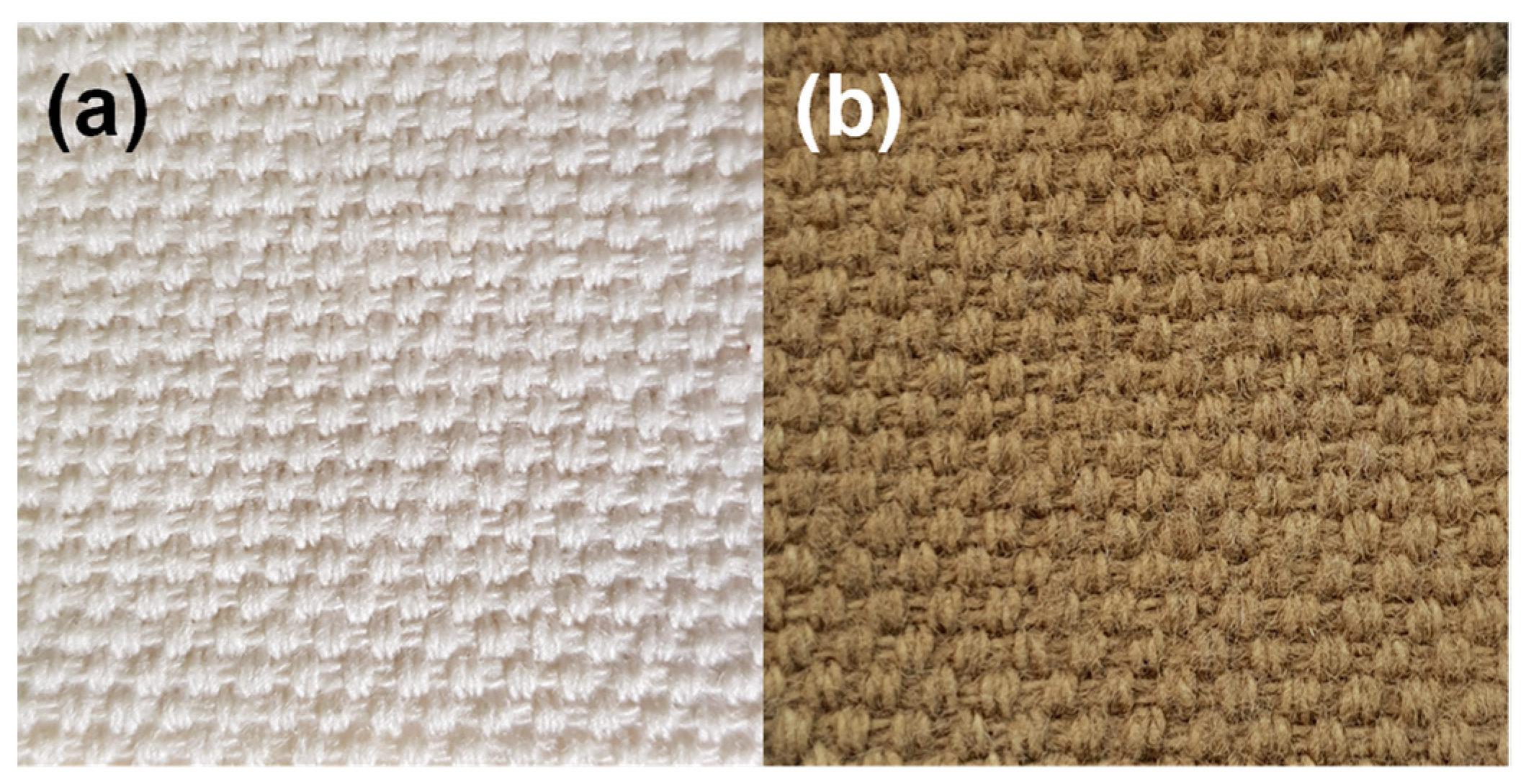
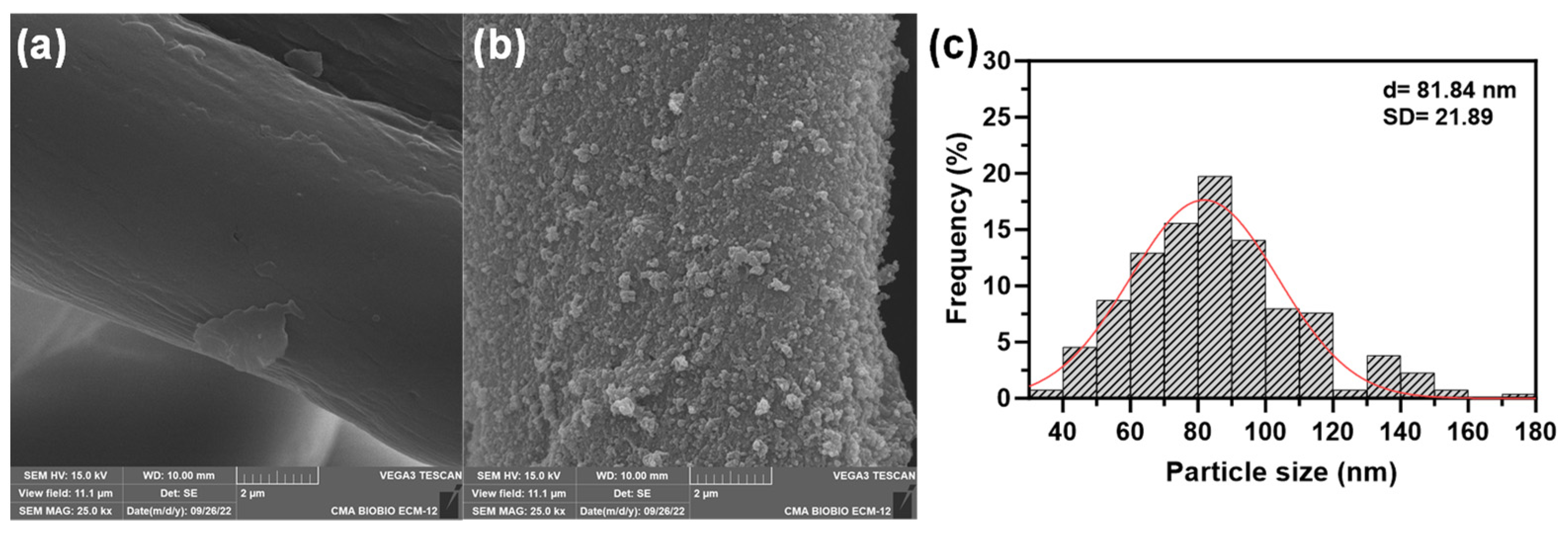
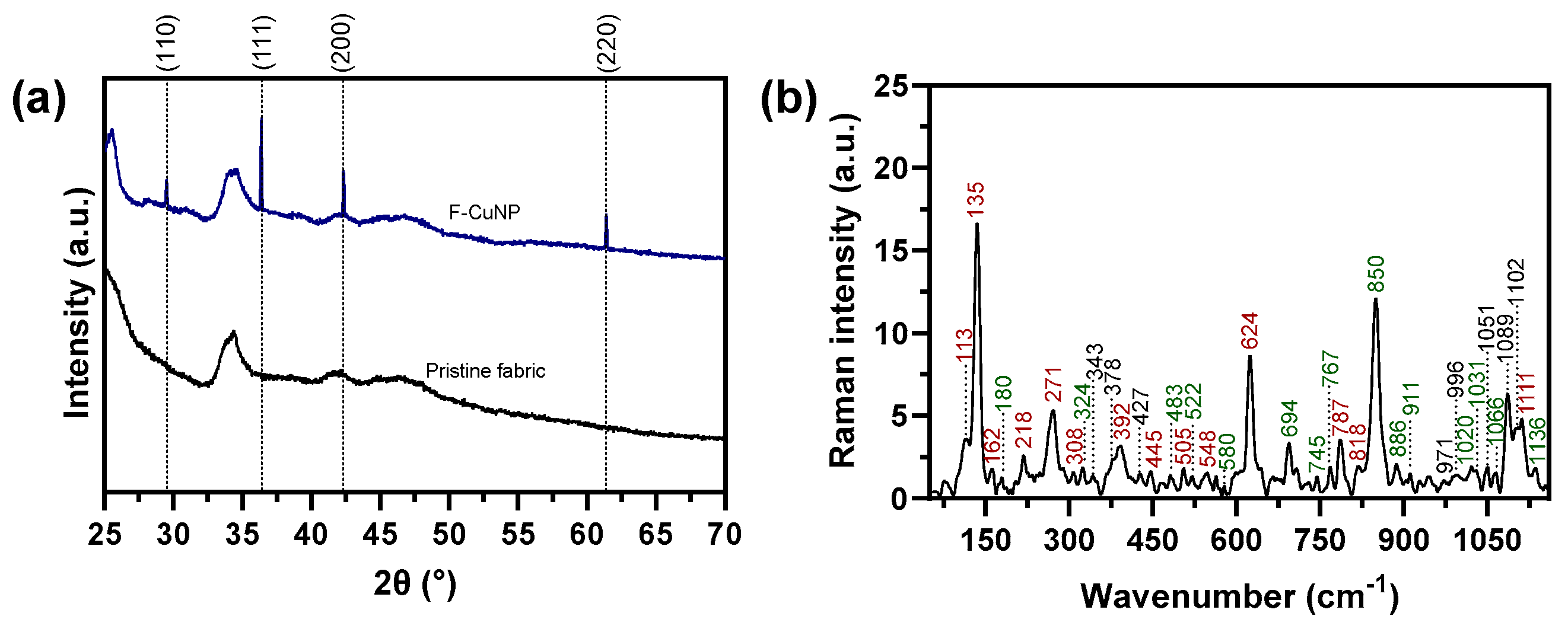
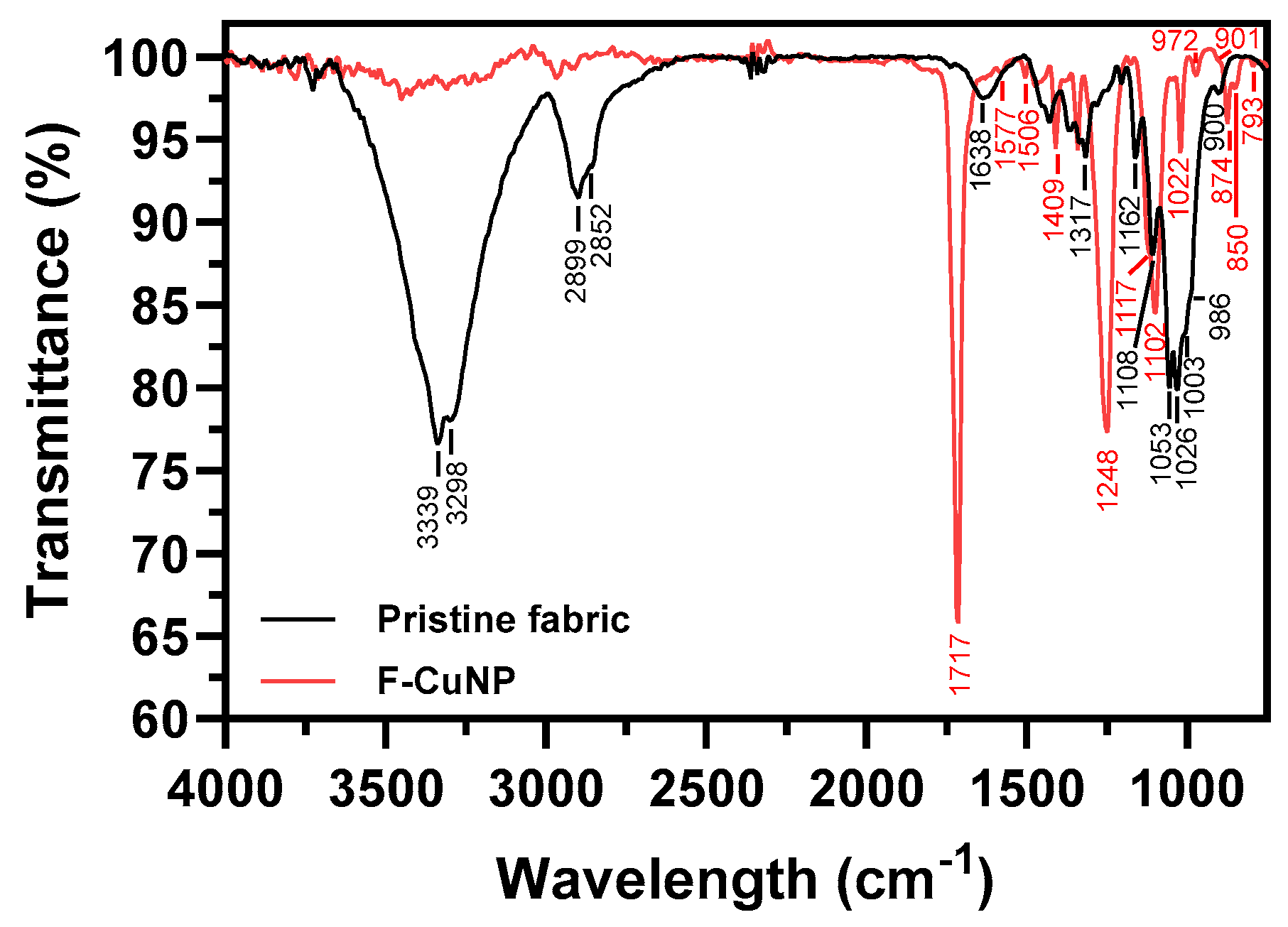

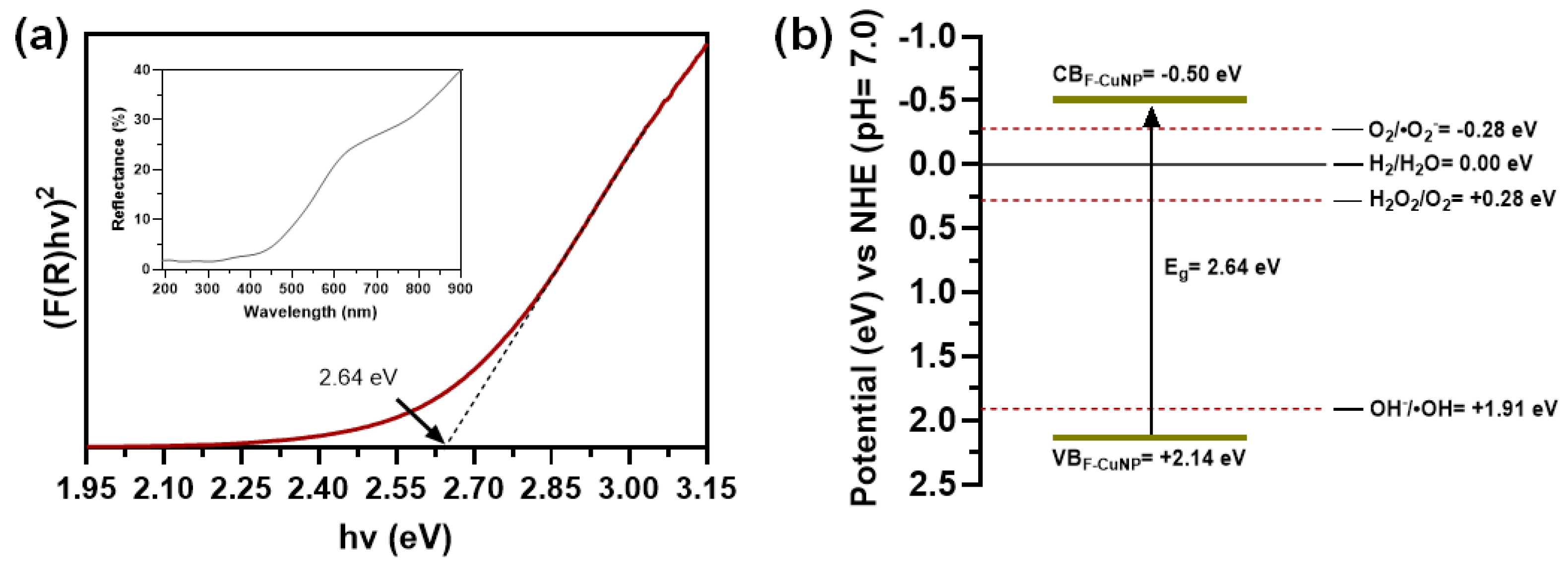

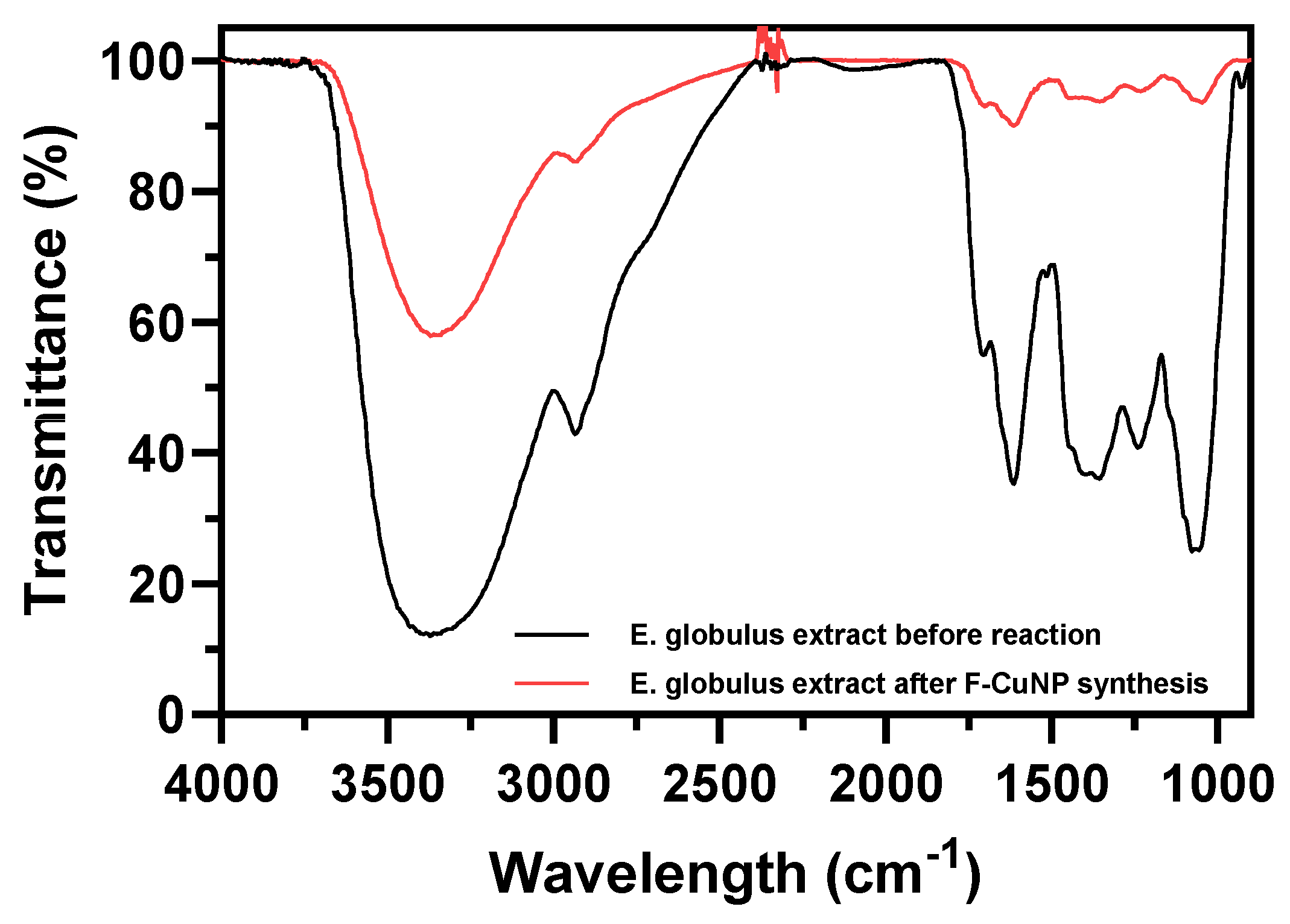

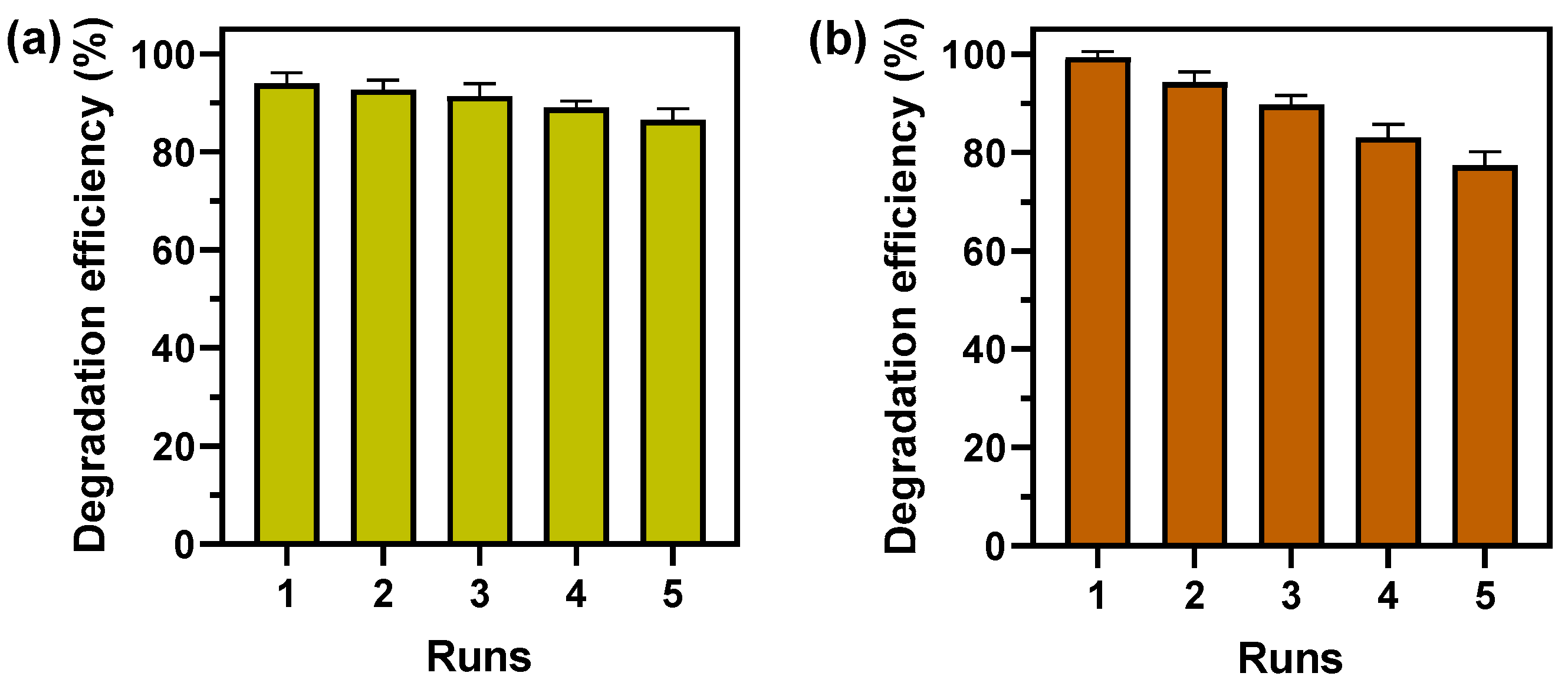


| Wavenumber (cm−1) | |||
|---|---|---|---|
| Pristine Fabric | F-CuNP | Vibration | Reference |
| 3339 | - | Intra-molecular hydrogen bonding C(3)OH⋯O(5) or C(6)O⋯(O)H | [40] |
| 3298 | - | Inter-molecular hydrogen bonding C(3)OH⋯C(6)O | [40] |
| 2899 | - | Asymmetric stretching vibration of —CH2 | [41] |
| 2852 | - | Symmetric stretching vibration of —CH2 | [41] |
| - | 1717 | C=O stretching | [42] |
| 1638 | - | O–H bending of adsorbed water | [40] |
| - | 1506 | C=C–C aromatic stretching | [42] |
| - | 1472 | -CH2 bending of methylene chains in lipids | [43] |
| 1458 | 1458 | O–H in-plane deformation | [40] |
| 1430 | - | CH2 scissoring | [44] |
| - | 1409 | C–OH stretching of alcohol | [45] |
| 1368 | - | C–OH bending | [42] |
| 1338 | 1339 | C–O stretching | [42] |
| 1317 | - | C–N stretch of aromatic amines | [46] |
| 1205 | - | C–O stretching | [40] |
| - | 1176 | Phenolic alcohol OH stretching | [45] |
| 1162 | - | Anti-symmetrical bridge C–O–C stretching | [44] |
| - | 1117 | –CN stretching | [47] |
| 1108 | 1102 | C–OH bending | [45] |
| 1053 | - | Stretching vibration of C–O–C in the pyranose skeletal ring | [15] |
| 1026 | 1022 | C–OH groups of cellulose | [40] |
| 1003 | - | C–O–H stretching vibration | [48] |
| 986 | 972 | C–O and ring stretching modes | [40] |
| 900 | 901 | Glycosidic deformation –C1–O–C4 characteristic of the β-glycosidic bond of cellulose | [44] |
| - | 874 | C–H out of plane glucose ring | [49] |
| - | 850 | Aromatic C-H out-of-plane deformation | [42] |
| - | 793 | C–H bending | [50] |
Disclaimer/Publisher’s Note: The statements, opinions and data contained in all publications are solely those of the individual author(s) and contributor(s) and not of MDPI and/or the editor(s). MDPI and/or the editor(s) disclaim responsibility for any injury to people or property resulting from any ideas, methods, instructions or products referred to in the content. |
© 2024 by the authors. Licensee MDPI, Basel, Switzerland. This article is an open access article distributed under the terms and conditions of the Creative Commons Attribution (CC BY) license (https://creativecommons.org/licenses/by/4.0/).
Share and Cite
Salgado, P.; Rubilar, O.; Salazar, C.; Márquez, K.; Vidal, G. In Situ Synthesis of Cu2O Nanoparticles Using Eucalyptus globulus Extract to Remove a Dye via Advanced Oxidation. Nanomaterials 2024, 14, 1087. https://doi.org/10.3390/nano14131087
Salgado P, Rubilar O, Salazar C, Márquez K, Vidal G. In Situ Synthesis of Cu2O Nanoparticles Using Eucalyptus globulus Extract to Remove a Dye via Advanced Oxidation. Nanomaterials. 2024; 14(13):1087. https://doi.org/10.3390/nano14131087
Chicago/Turabian StyleSalgado, Pablo, Olga Rubilar, Claudio Salazar, Katherine Márquez, and Gladys Vidal. 2024. "In Situ Synthesis of Cu2O Nanoparticles Using Eucalyptus globulus Extract to Remove a Dye via Advanced Oxidation" Nanomaterials 14, no. 13: 1087. https://doi.org/10.3390/nano14131087
APA StyleSalgado, P., Rubilar, O., Salazar, C., Márquez, K., & Vidal, G. (2024). In Situ Synthesis of Cu2O Nanoparticles Using Eucalyptus globulus Extract to Remove a Dye via Advanced Oxidation. Nanomaterials, 14(13), 1087. https://doi.org/10.3390/nano14131087







